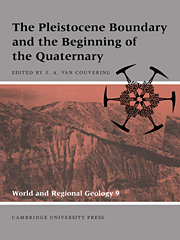Book contents
- Frontmatter
- Contents
- List of contributors
- Preface: the new Pleistocene
- Foreword
- Part I Definition of the base of the Quaternary
- Part II Characterization of the Pleistocene boundary-stratotype
- Part III The paleontological context of the Pleistocene boundary
- 7 The Pliocene–Pleistocene boundary in deep-sea sediments
- 8 Late Cenozoic changes of flora in extra-tropical Eurasia in the light of paleomagnetic stratigraphy
- 9 Plio–Pleistocene mammal faunas: an overview
- 10 Human evolution in the Plio–Pleistocene interval
- Part IV The Pleistocene boundary in regional sequences
- Index
10 - Human evolution in the Plio–Pleistocene interval
Published online by Cambridge University Press: 10 November 2009
- Frontmatter
- Contents
- List of contributors
- Preface: the new Pleistocene
- Foreword
- Part I Definition of the base of the Quaternary
- Part II Characterization of the Pleistocene boundary-stratotype
- Part III The paleontological context of the Pleistocene boundary
- 7 The Pliocene–Pleistocene boundary in deep-sea sediments
- 8 Late Cenozoic changes of flora in extra-tropical Eurasia in the light of paleomagnetic stratigraphy
- 9 Plio–Pleistocene mammal faunas: an overview
- 10 Human evolution in the Plio–Pleistocene interval
- Part IV The Pleistocene boundary in regional sequences
- Index
Summary
Introduction
For many years, the main problem in relating the Pliocene–Pleistocene boundary to human evolution has been the controversy over “Tertiary man.” For some, this has had serious philosophical implications arising from the definition of the Quaternary period in anthropological terms. The development of modern stratigraphical standards, however, makes this a merely nominal question, because such boundaries are now based entirely on geological principles. At the same time, the terms “Tertiary” and “Quaternary,” having been drawn from primitive concepts of stratigraphy that once also distinguished a “Primary” and a “Secondary,” have been called into question. Nevertheless, the chronology of early humans is pertinent to the goal of this project, for other than merely historical reasons.
The search for fossil Hominidae in the past three decades has produced an immense amount of geological and paleontological evidence. In Africa, particularly, well-exposed and relatively thick Plio–Pleistocene sections yielding abundant remains of Hominidae and a wide diversity of other fossils have been very well characterized in terms of biochronology, and also with reference to magnetostratigraphy and isotopic dates. Similar data, if not so well developed, have been recovered from other areas as a direct result of paleoanthropological studies.
It is now clear that key events in human evolution occurred within the time interval that also encompassed the Pliocene–Pleistocene boundary (i.e., within the limits of the Matuyama paleomagnetic chron, from 2.6 to 0.8 Ma) (Figure 10.1). It was during that time that the genus Homo first appeared in Africa, giving rise to the key species Homo habilis Leakey, Tobias, and Napier, at about 1.8 Ma, almost exactly coincident with the beginning of the Pleistocene.
- Type
- Chapter
- Information
- The Pleistocene Boundary and the Beginning of the Quaternary , pp. 129 - 138Publisher: Cambridge University PressPrint publication year: 1996



